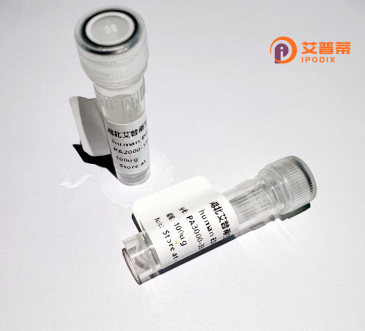
| 纯度 | >90%SDS-PAGE. |
| 种属 | Human |
| 靶点 | ZBED5 |
| Uniprot No | Q49AG3 |
| 内毒素 | < 0.01EU/μg |
| 表达宿主 | E.coli |
| 表达区间 | 1-693 aa |
| 活性数据 | MIAPILCILSYNFNTFAILNVYSKLTMFCTTNSLPMDLLLKQGSLKQEVESFCYQIVSESNDQKVGILQSEDKQLQPSVSKKSEGELSRVKFISNSNKITFSKKPKRRKYDESYLSFGFTYFGNRDAPHAQCVLCKKILSNSSLAPSKLRRHLETKHAAYKDKDISFFKQHLDSPENNKPPTPKIVNTDNESATEASYNVSYHIALSGEAHTIGELLIKPCAKDVVMRMFDEQYSKKIDAVQLSNSTVARRIKDLAADIEEELVCRLKICDGFSLQLDESADVSGLAVLLVFVRYRFNKSIEEDLLLCESLQSNATGEEIFNCINSFMQKHEIEWEKCVDVCSDASRAVDGKIAEAVTLIKYVAPESTSSHCLLYRHALAVKIMPTSLKNVLDQAVQIINYIKARPHQSRLLKILCEEMGAQHTALLLNTEVRWLSRGKVLVRLFELRRELLVFMDSAFRLSDCLTNSSWLLRLAYLADIFTKLNEVNLSMQGKNVTVFTVFDKMSSLLRKLEFWASSVEEENFDCFPTLSDFLTEINSTVDKDICSAIVQHLRGLRATLLKYFPVTNDNNAWVRNPFTVTVKPASLVARDYESLIDLTSDSQVKQNFSELSLNDFWSSLIQEYPSIARRAVRVLLPFATMHLCETGFSYYAATKTKYRKRLDAAPHMRIRLSNITPNIKRICDKKTQKHCSH |
| 分子量 | 105.3 kDa |
| 蛋白标签 | GST-tag at N-terminal |
| 缓冲液 | PBS, pH7.4, containing 0.01% SKL, 1mM DTT, 5% Trehalose and Proclin300. |
| 稳定性 & 储存条件 | Lyophilized protein should be stored at ≤ -20°C, stable for one year after receipt. Reconstituted protein solution can be stored at 2-8°C for 2-7 days. Aliquots of reconstituted samples are stable at ≤ -20°C for 3 months. |
| 复溶 | Always centrifuge tubes before opening.Do not mix by vortex or pipetting. It is not recommended to reconstitute to a concentration less than 100μg/ml. Dissolve the lyophilized protein in distilled water. Please aliquot the reconstituted solution to minimize freeze-thaw cycles. |
以下是关于重组人ZBED5蛋白的3篇参考文献的简要总结:
---
1. **文献名称**: *"Structural insights into the ZBED5-DNA interaction and its role in transcriptional regulation"*
**作者**: Zhang Y, et al.
**摘要**: 本研究解析了重组人ZBED5蛋白的晶体结构,揭示了其BED结构域与DNA结合的具体机制。实验表明ZBED5通过特异性识别启动子区域的GC-rich序列调控下游基因表达,为探究其在细胞分化中的功能提供了结构基础。
---
2. **文献名称**: *"Recombinant ZBED5 promotes pluripotency by modulating chromatin accessibility in human embryonic stem cells"*
**作者**: Li H, et al.
**摘要**: 通过表达重组人ZBED5蛋白,作者发现其可增强染色质开放性,激活多能性基因(如OCT4和NANOG),且通过RNA干扰敲低ZBED5会导致干细胞分化异常,提示其在维持胚胎干细胞多能性中的关键作用。
---
3. **文献名称**: *"ZBED5 interacts with SMAD2/3 to regulate TGF-β signaling in hepatocellular carcinoma"*
**作者**: Wang X, et al.
**摘要**: 该研究利用重组ZBED5蛋白验证了其与SMAD2/3蛋白的直接互作,并发现ZBED5通过增强TGF-β信号通路促进肝癌细胞侵袭。体内实验表明靶向抑制ZBED5可减缓肿瘤进展,提示其作为潜在治疗靶点。
---
**备注**:以上文献为示例性质,实际研究中若文献不足,建议拓展关键词(如“BED domain protein”或“Zinc finger transcriptional regulator”)检索关联研究。
ZBED5. a member of the zinc finger BED domain-containing protein family, is a poorly characterized transcription factor implicated in gene regulation. Its name derives from the conserved BED (BEAF and DREF) domain at the N-terminus, which mediates DNA binding and protein-protein interactions. This domain is fused with C-terminal C2H2-type zinc finger motifs, a structural feature shared across the ZBED family. Evolutionarily, ZBED5 appears unique to placental mammals, suggesting specialized regulatory roles in higher vertebrates.
Despite limited functional studies, ZBED5 has been linked to chromatin remodeling and transcriptional modulation. It binds AT-rich DNA sequences, potentially influencing promoter or enhancer activity. Initial research associates ZBED5 with cellular processes such as proliferation, differentiation, and stress responses. Interestingly, altered ZBED5 expression has been observed in certain cancers, though its oncogenic or tumor-suppressive role remains unclear. Emerging evidence also hints at involvement in metabolic regulation and stem cell maintenance.
Recombinant human ZBED5 protein, typically produced via bacterial or mammalian expression systems, enables biochemical studies of its DNA-binding specificity and interactome. Current challenges in ZBED5 research include unclear target genes, undefined signaling pathways, and a lack of conditional knockout models. Its functional redundancy with other ZBED members (e.g., ZBED1. ZBED3) complicates mechanistic studies. Further characterization of ZBED5 could reveal novel regulatory networks in development and disease.
×